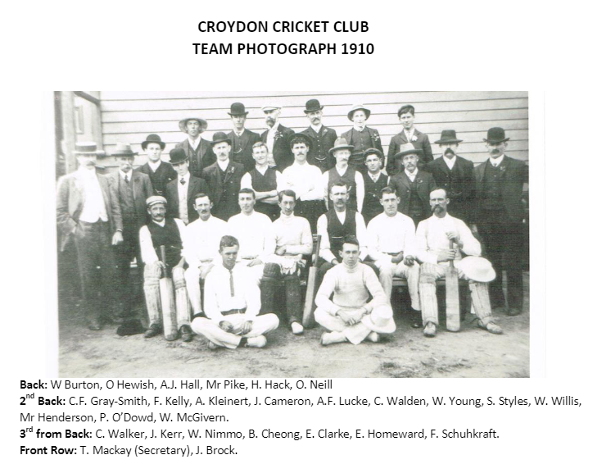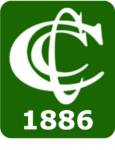
The Croydon Cricket Club was officially formed in 1885. James Hewish was the first president and William McGivern the first captain. (In those days the captain was distinguished from the other players by a ‘fiery’ red handkerchief he wore on his belt.) Details of the club’s first days are at the least sketchy, but many agree that Croydon is the oldest established club in the eastern suburbs.
Croydon played its first games on Holmwood land (originally H. Turner’s), which is now occupied by the Wyreena Community Centre on Hull Road. On or around 1905 it became its first official council-owned ground. T.H. Gwillam had offered the land for sale; it was eventually bought by the Lillydale Shire Council at 15 pounds per acre and became a recreation reserve. The club also played games on the site of the present post office settling at its current home, Croydon Park, in 1937. In 1886 S. Parry was Croydon’s captain, W. Sherlock was vice-captain, and J.T. Burke was secretary. Players included Dickerson, Parry, Jenkins, Sherlock, S. Styles, M. McGuiness, McGivern, Wirk, Windley, Hardidge, Grady, E. Styles and Hargood. Rumours that David Howes debuted in that season are yet to be confirmed.
The late 1880s saw Croydon becoming more established in the area, as that year the press reported that ‘the Croydon club have lately gone to a lot of trouble to improve their ground and on Saturday it was in first class order’. A small medallion in the possession of Mrs Margaret Scrivener, grand-daughter of the former Croydon player, William Sherlock, also produces evidence of the club organisation and trophy presentations 96 years ago. The back of the medal (which is gold, about an inch in size, and in the form of a cross patee with eight arms), is minutely engraved as follows: “President’s prize. Croydon Cricket Club. Season 1889. Presented by R.B. Kelly Esq. to William Sherlock – best all- round player.” A similar medal in silver was presented to the best bowler – Sam Styles.
At the turn of the century, Croydon players included S. Styles, C. Walker, C. Robinson, A. Campbell, A. Kleinert, W. McGivern, Mathews, J. Kerr, F. Thomas, H. Thomas and J. Gordon. In 1905, evidence of the social activity within the club appeared with a CCC concert being held. On August 25, the local press reported: “The Croydon Cricket Club have decided to take steps towards forming an association next season and intend calling a meeting for that purpose. Notice will be sent to the various clubs requesting the attendance of delegates, and in order that a fair test of feeling may be obtained, the secretaries of the district clubs are invited to interview their members and get their opinions thereon. The meeting will b e held at Lilydale, as that place is regarded as the most suitable headquarters.” Croydon ’s proposal was taken up on August 3 the following year: “At a meeting of delegates form the local and district cricket clubs held at the Olinda (a hotel in Lilydale), it was decided to form an association this season and compete for a trophy which has been generously donated by C.J. Mitchell. The clubs represented at the meeting and who have joined in the association are Lilydale, Mooroolbark, Croydon, Wandin , Seville and Coldstream.” Croydon won the first grand final in 1906/07, and were presented with the C.J. Mitchell trophy for their efforts.
The 1920d proved to be one of the most eventful periods in the history of the club. Croydon began the decade in fine style, winning the 1919/20 premiership against old rivals Mooroolbark in the first and only season of the Croydon District Cricket Association. After the match a trophy was presented to Croydon by Dame Nellie Melba’s brother, Harry Mitchell. Dame Nellie was LDCA president at one stage.
The Ringwood District Cricket Association, which Croydon was a part of, was formed in 1920. The first round in the new competition was played on October 23 and 30, 1920, with the original teams being Croydon, Diggers (returned soldiers), Ringwood, Mooroolbark, Montrose and Wonga Park. Mooroolbark avenged its defeat the previous year by winning the first RDCA pennant. It was during this season that Croydon was involved in an inter-association game for the first time. G. Fleming, B. Cheong and F. Leech all represented Croydon in the match, which the RDCA, 98 and 2/13, lost to Box Hill Reporter, 229. Croydon won its first RDCA premiership in 1925/26, against the relatively new Ringwood Churches side.
A number of milestones occurred at the club in 1928. Croydon changed its colours from blue andgold to green and gold, and one of its most respected members, Mr Joshua Cheong, died after a longillness. Mr Cheong had lived in Croydon for 33 years, and was made a life-member of the CroydonCricket Club in 1927. The Upper Yarra Advocate described him as ‘a most popular resident and enthusiastic and prominent cricketer’.
In 1931, Oliver Hewish, whose name was synonymous with the Croydon club in its early years, donated 50 acres of land to the Shire for the use of sporting bodies in Croydon. This land included what is now Croydon Park. Croydon moved there shortly after from the Hall grounds.
Construction of the current pavilion began on March 8 1954, which wasn’t a moment too soon for the 1952/53 secretary who had said of existing facilities at the time: “Unfortunately the old tin shed is a direct contrast to our lovely oval and surroundings, but until this eyesore collapses completely I’m afraid we can’t hope for anything much better.” A ladies’ auxiliary, which organised a Christmas hamper raffle, was formed that year. November 1959 saw the much-awaited official opening of the new pavilion. The local press noted: “The pavilion has an upper stand which will seat 400 people, and commands a panoramic view of the Dandenong Ranges and surrounding countryside. It was built largely by local volunteer labour, and the various sporting bodies rolled their sleeves up and tucked in vigorously under the supervision of the contractor, Mr E. Wagner. Croydon entered two sides in the Eastern Suburbs Cricket Association (ESCA) for the 1965/66 season, and with the help of the Croydon Shire, laid the first turf wicket on the main oval.
Nine teams competed in 1943/44, and 10 in 1944/45. The highlights of these seasons should really be described as ‘lowlights’, due to the lack of players and competition. In one game Croydon made 18 against Ringwood which included 6 ducks, and in another Ringwood made 38 and then dismissed Croydon for 11 to win the match. Forfeits were also not uncommon then. Croydon won its first post-war premiership in 1946/47, when the C Grade side defeated Croydon North by an innings and 128 runs. A Grade also made the grand final the following season, 1947/48, but were defeated by Montrose.

